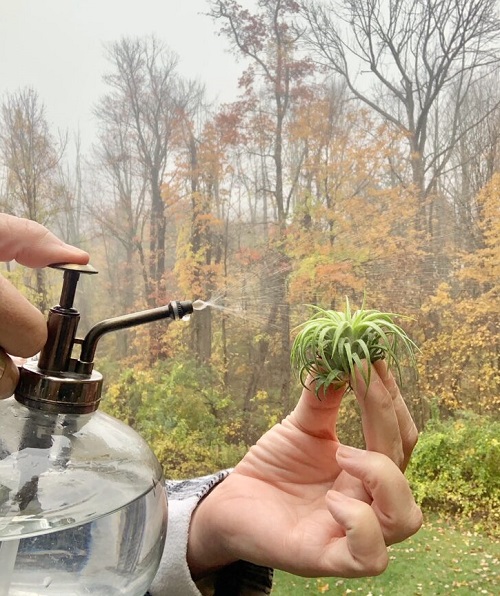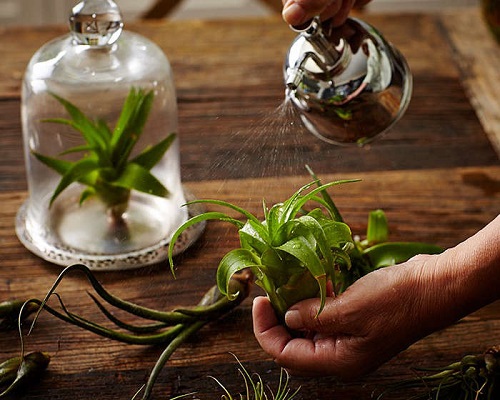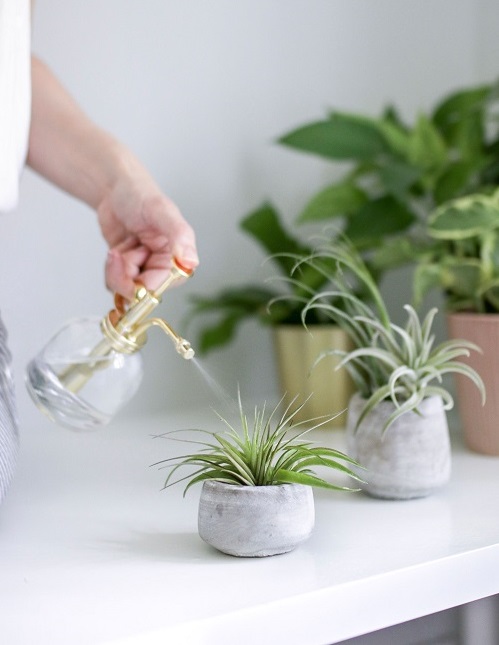If you are looking for tips on How To Water Air Plants like a pro to keep them healthy, then you are in the right place. Keep reading!
As you know, these air plants do not have roots like other plants have. Usually, these plants absorb nutrients present in the air. How? It’s due to the small hair called trichomes; by looking closely, you can see them. These help in soaking the moisture from the environment. However, that does not mean they do not need to be watered. They need watering, especially if you are growing them as houseplants.
Learn How to Water Orchids
About Air Plants
Air plants, also known as Tillandsia, are unique plants that don’t require soil to grow. They are epiphytes, which means they grow on other plants or objects, like tree branches or rocks, and absorb moisture and nutrients from the air through their leaves.
Air plants come in a variety of sizes, from small and delicate to large and statement-making. They can have curly or straight leaves, and some varieties even bloom with vibrant flowers. One of the most unique features of air plants is their ability to change color depending on their environment, with some species turning a vibrant red or pink when they’re about to bloom.
While air plants are low-maintenance, it’s important to note that they have slow growth habits. They grow by producing offsets, also known as pups, which can take several months to appear. These pups will eventually grow into mature plants and will start producing their own offsets, creating a never-ending cycle of growth.
How to Water Air Plants?
Watering air plants may seem like a daunting task, but it’s actually quite simple once you know the basics. Unlike traditional potted plants, air plants don’t need soil to survive.
Make sure to soak your air plants regularly. Wondering how long to water air plants? Fill a bowl or sink with lukewarm water and let your plants soak for about 30 minutes. After soaking, gently shake off any excess water and place the plants in a well-ventilated area to dry. Be sure to allow your plants to dry completely before returning them to their display.
Pay attention to your air plants’ environment. Air plants thrive in humid environments, so if your home is particularly dry, you may need to mist your plants with water every few days. Alternatively, you can place your air plants near a humidifier or in a bathroom with a shower to increase the humidity levels.
Best Water for Air Plants
When it comes to watering air plants, the type of water you use is just as important as how you water them. Tap water can contain minerals and chemicals that can harm your air plants over time, so it’s best to use filtered or distilled water.
Filtered water is a great option for this, as it removes many of the harmful minerals found in tap water. If you don’t have access to filtered water, distilled water is another great option. Distilled water is free from minerals and chemicals, making it a safe and effective choice.
It’s important to note that while rainwater is often touted as the best choice, it’s not always a feasible option for everyone. If you do choose to use rainwater, be sure to collect it in a clean container and allow it to sit for a few hours to dissipate any potential pollutants. By using the best water for your air plants, you can ensure that they thrive and stay healthy for years to come.
Tips on Watering Air Plants

1. Consider the Weather
How much water your air plants need and how frequently depends upon the climate and season. In summer, when the weather is hot and dry, bathe the plants more frequently, i.e., about once a week.
Wondering how often to water air plants in winter and how long to soak them in water? In the winter season, when the weather is cold, soaking them once every two to three weeks is enough. Take note of the health of your plant with the changing seasons and increase or decrease watering according to that.
2. Air Plant Species Matters
Water according to the species you’re growing. Research about its native habitat, such as whether it grows in shady, humid lower levels of rainforests or full sun on the Andes. Remember that gray and white varieties with thicker leaves require less watering and humidity.
Green species, on the other hand, with finer leaves, need more watering and humidity.
Best Ways to Water Air Plants
1. Spritzing
One common method most people use to water air plants is Spritzing. You can use a misting bottle to spritz air plants twice a week. This method is sufficient if you live in humid conditions or if the air plants are in greenhouses. Wondering how to water mounted air plants? Spritzing, of course!
But if you have dry indoor conditions, then spritzing alone won’t be enough.
2. Soaking

It might be clear from the title that we are going to discuss soaking air plants. But why does the need for soaking arise? Isn’t spritzing enough? To answer it simply, it’s not!
In dry indoor conditions, air plants can’t solely survive on spritzing. Dunking them in water is the best way to ensure that they remain fresh and growing.
Apply this soaking method once a week for around 20-30 minutes in a cool climate and 30-60 minutes in a hot, arid climate. Every 3 weeks, give your air plants a good soak for about a couple of hours long duration, especially in summer.
- You’ll need a bucket, bowl, or sink to submerge them in water. Use room-temperature water!
- Keep them in water for some time (as instructed above), and make sure the water level is high enough to cover entire plants.
- After a good soaking, lift the plants up in an upside-down position.
- Get rid of excess water present on or inside the leaves by shaking the air plants.
- Before returning the plants to their original spot, ensure no water is left on the leaves, and they are fully dry to the touch. If necessary, place the plants on a paper towel in a bright spot for a while.
- Once dry, bring the plant back to its location.





